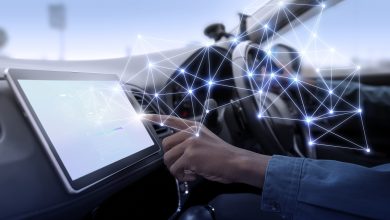Advanced algorithms and approaches for vehicle telematics

Modern telematics platforms utilize various advanced algorithms to address common tasks such as vehicle routing, face recognition, driver behavior identification, eco-driving, and vehicle classification. Here we consider only a few such algorithms and describe the cases where they either might or have been used.
Algorithms and cases
To begin with, let’s consider some approaches to vehicle routing. The possibility to determine, modify, and optimize possible routes is a crucial feature for any telematics platform.
One approach to vehicle routing could be provided by game theory. A potential of game theory in the building and analysis of behavioral models could be successfully utilized to address logistics and fleet management problems.
Assume that node O is connected to the rest of the network through connection points A and B, where A is a little closer than B. However, both connection points get easily congested, therefore sending both streams via the same connection point would result in an extra delay. Favorable outcomes in this game would be for the two players to “coordinate” and send their traffic through different connection points.
On practical case one have to deal with a decent amount of fleets and need to optimize the route for each of them. It is a really challenging task to deal with and there are various smart algorithms, methods, and programming paradigms being used and developed to provide some practical solutions.
Navixy utilize smart algorithms combined with advanced features of constraint programming and multi-purpose meta-heuristic techniques to account for everyday fleet management needs and addressing VRP in a highly efficient and customer-beneficial way. By simply clicking on the route optimization button, a dispatcher will instantly get the optimal sequence of locations to visit on the map. One-click and all the points line up in the most effective route.
Another example is face recognition routine in MDVR systems.
Facial recognition performs capturing and analysis with further comparison of specific face patterns based on the facial details of a particular person, and contains three steps:
1) detection process detects and locates human face on image or videos;
2) relying to the face features, capture process does analog to digital conversion, transforming actual face to digital information;
3) matching process checking if two faces belong to same human;
There are several ways of Face Recognition implementation, including MDVR functionality enabling by different telematics platforms, currently available on the market.
For instance, Howen’s online video monitoring system provides fleet owners the opportunity to control driver behavior behind the wheel and ensure cargo safety in real-time.
Another approach to controlling driver behavior is utilizing Fuzzy logic. Due to its ability to deal with uncertainty, fuzzy logic could successfully be utilized in many real-world applications, and telematics is not an exception. Some research outputs [S. Ghaemi et al, 2010] managed to demonstrate a hierarchical fuzzy system for humans in a driver-vehicle-environment system to model takeover by different drivers.
Fuzzy logic provides fruitful features to telematics, but it should be pointed out that such solutions are not alternative-less. For instance, an innovative telematics platform may utilize other advanced algorithms and solutions, allowing efficient driver behavior control.
Machine learning methods demonstrated reliable results in many applications, including pattern recognition (face detection), unusual patterns detection (sensors), and predictive analytics (stock/exchange rates and prices).
Taking into account current progress in general connectivity, IoT, and IoV, machine learning could actually utilize both real-time and historical data for insightful analytics. As such, machine learning methods could be employed in predictive maintenance, driver behavior analysis, insurance telematics, driver identification, ADAS systems, and autonomous vehicles.
To provide an example, let’s consider a Driver Identification system framework, described in [A. Girma et al., 2019].
The model developed by the authors is based on freely available vehicle telematics data being collected from the OBD-II interface of vehicles. The actual problem is formulated as a time-series prediction task, where the model is trained on sequential data obtained from an in-vehicle sensor. The approach proposed by the author’s claims to maintain its accuracy above the acceptable value, 88%, while other models’ accuracy goes below 40%.
Machine learning implementation could also be rather challenging, due to requirements on proper choice of algorithm, often lack clarity between training and test set, features engineering importance, and requirements on problem definition. Therefore, in some cases, it could be useful to employ other solutions.
The above-mentioned case of driver identification could be alternatively replaced by the advanced functionality of the telematics platform. Such driver ID functionality will be extremely useful for companies and enterprises where several drivers share the same vehicle. This function will make one aware of who is driving the vehicle at any given moment.
Provided examples are just a thin slice out of a large cohort of available algorithms and approaches addressing telematics and transportation tasks. However, even such small selection quite desperately shows how rapidly modern computing and technological approaches diffusing into telematics.
Author:
Shamil Mirkhanov, MSc, MBA, PhD.
Technology Distribution Expert at Navixy
Published in Telematics Wire


